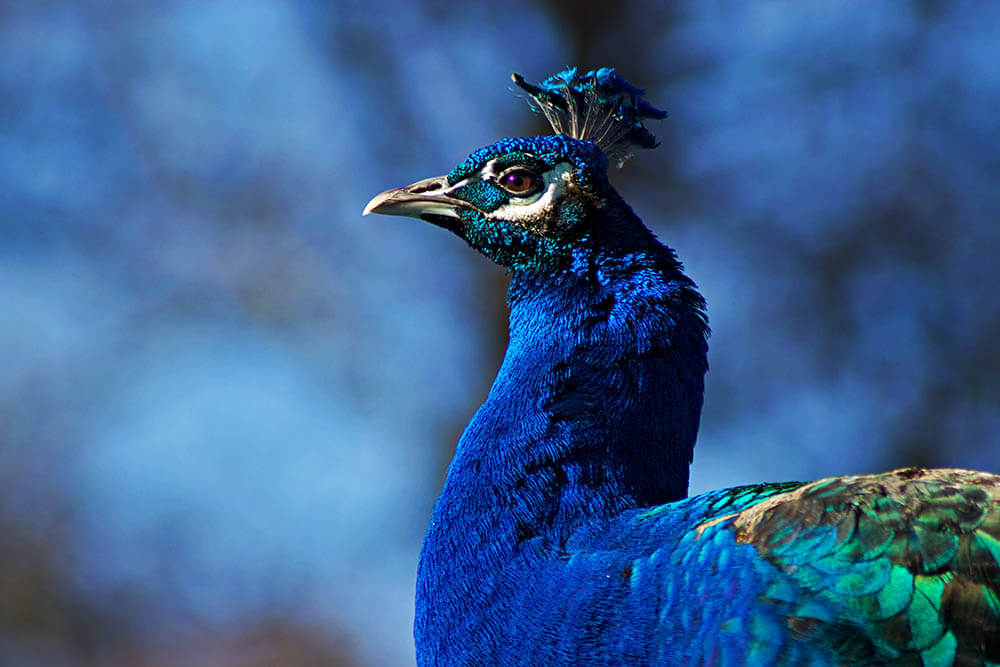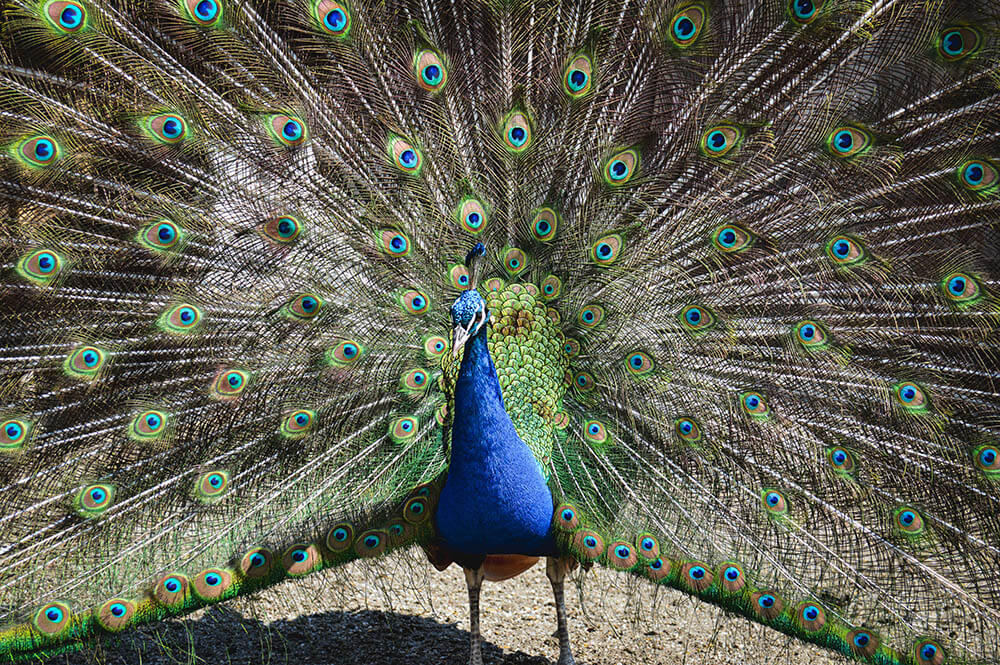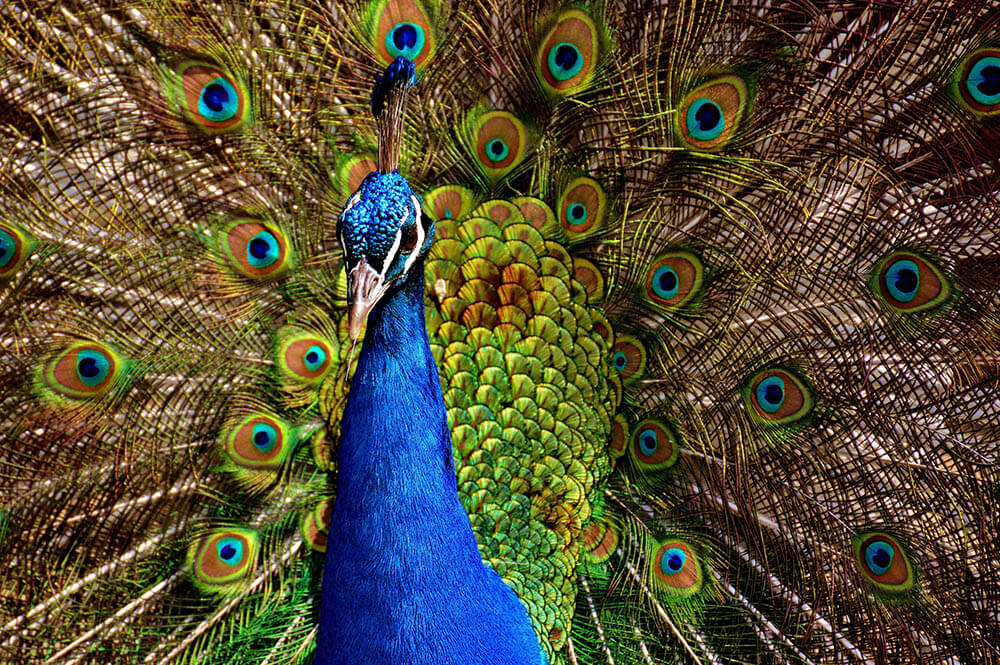We think of birds as fragile, short-lived animals that barely have a decade before crossing over into the great beyond. This, however, couldn’t be further from the truth.
The fact is, many avian species live long lives, among them the fabulous peafowl. Yes, these birds are not only beautiful but also hardy enough to stick around for years and years.
So how long do peafowl live, exactly? Let’s find out!
Note: while these birds are popularly known as “peacocks,” the proper, gender-neutral term for the species is “peafowl.” Peacocks are male peafowl, while peahens are female peafowl.

First of All, What Is a Peafowl?
If you’ve ever seen a brightly colored bird spreading out its long tail feathers in the shape of a large fan, then you likely already know what a peafowl is. What might come as a surprise to some is that this behavior is only displayed by male peafowl a.k.a. peacocks. Peacocks do this during the mating season to impress peahens, who then mate with the males they find most attractive.
There are three peafowl species: the blue or Indian peafowl (Pavo cristatus), which is naturally found in the Indian subcontinent; the green peafowl (Pavo muticus), which makes its home in the region between Myanmar and Java; and the uncommon Congo or African peafowl (Afropavo congensis), which is endemic to Central Africa, particularly the forested areas of the Democratic Republic of Congo.
Now that we have a good idea of what peafowl are, on to today’s question…
How Long Do Peafowl Live?
Whether they live in India or Central Africa, peafowl are among the most long-lived birds in the animal kingdom.
In the wild, peafowl can live for about 10 to 25 years, averaging 14 to 15 years.
In captivity, however, they can live for much longer if given exceptional care – between 30 and 50 years!
But what is the peafowl lifecycle like? At what age do they mature and become capable of procreation?
The peafowl lifecycle
Because they live so long, peafowl lifecycles are slow.
Once a peahen produces eggs, incubation takes between 28 and 30 days. When peachicks hatch after this period, it only takes them a few hours before they can walk and eat by themselves. They’re also born covered with flight feathers, allowing them to fly short distances.
This doesn’t mean peachicks can already take care of themselves, however; a mother peahen looks after her young and teaches them valuable life lessons such as what to eat, what not to eat, how to communicate with other peafowl, how to take care of their feathers, and how to avoid danger. Every mother is also fiercely protective of her young and won’t hesitate to attack any creature that threatens them.
Peachicks don’t become truly independent until they’re four to six months old, which is when their mother leaves them to fend for themselves.
Peafowl don’t reach full sexual maturity until they’re between two and three years of age. Peahens can already produce a few eggs around this time, but they have to wait till they’re four years old before they can lay the typical five to nine eggs per clutch.
How to tell a peafowl’s age
It’s difficult to determine how old an adult peafowl is. However, there are various ways to tell the age of a younger peafowl.
A newborn peachick has soft yellow down. This turns brown once the individual reaches its first year.
Upon reaching his second year of life, a peacock’s plumage starts growing colorful. His tail feathers also develop iridescent colors and many oval shapes resembling large, vibrant eyes. If we’re talking about a blue peacock, he should weigh a maximum of 15 pounds.
As for peahens, they retain their brown feathers. However, you can expect those feathers to be larger on a two-year-old individual. Her neck also develops iridescent feathers. In addition, she’ll be able to start laying a few eggs per clutch. A blue peahen should weigh up to 10 pounds.

At three, the peafowl is fully grown. A peacock has a full set of eye tail feathers and can spread said feathers to form the shape of a fan. Both peacocks and peahens boast full-sized tail feathers and their maximum size.
Once a peafowl is three years old, it becomes difficult to pinpoint its exact age as its body ceases undergoing drastic changes. Peafowl keepers need to tag their birds and keep a record of their age to determine how many years they’ve been alive.
How most peafowl die
Peachicks have a mortality rate of around 50%, which means most peafowl perish during the earliest stage of their life.
There are many reasons why peachicks die. For one, as they’re smaller and unable to defend themselves, they make easier prey for predators than adult peafowl. They’re also more vulnerable to starvation, disease, and even attacks by fellow peafowl including older chicks.
Peahen mothers in captivity are less attentive than their wild counterparts, so some peachicks die due to neglect.
Upon reaching full maturity, peafowl become vulnerable to a wide range of diseases. Captive peafowl are in particular danger of being exposed to diseases such as fowlpox, avian flu, laryngotracheitis, mycoplasma, and many endoparasites.
In their natural habitats, peafowl fall prey to wild dogs, wolves, lions, tigers, leopards, raccoons, mongooses, and the like.
As if natural predation wasn’t bad enough, we humans also hunt peafowl for their feathers and meat. Thankfully, the killing of peafowl has been illegalized in certain regions of the world.
Lastly, there’s habitat loss – a serious issue threatening the survival not only of peafowl but also many other species. As human activity encroaches upon or destroys the tropical and subtropical forests these birds call home, the fewer the places they can retreat to whenever they need to keep themselves safe from predators.

Why Do Peafowl Live Long Lives?
Despite having several predators and being vulnerable to diseases, peafowl face fewer threats than other types of birds.
Peafowl also enjoy many advantages, such as:
They’re aggressive
Peafowl are aggressive creatures that are known to viciously attack anything they see as a danger to themselves, their offspring, and their territory. And because they’re none too bright, they may see even the most innocent gesture as a threat.
Their sharp beaks and even sharper talons can lethally wound smaller creatures and cause painful injury to larger ones. In fact, in India, they’re used to ward off and kill snakes, including the deadly King Cobra. It’s because of their cantankerous nature, willingness to fight, and ability to cause harm that many animals think twice about crossing them.
Humans aren’t safe from the peafowl’s nasty temper, either. There are many cases of free-roaming peafowl attacking people, especially children, in zoos. In some cases, these experiences are so traumatic that victims develop pavophobia – the irrational fear of peafowl. In one unfortunate incident, a pet peafowl even killed an adult human.
They can fly
Peafowl aren’t the most impressive flyers. They can reach a top speed of around 10 miles per hour (mph), which is only slightly faster than the chicken’s 8.7 mph, slower than the turkey’s 50 mph and the pheasant’s 60 mph, and way behind the pigeon’s 150 mph.
Peafowl generally don’t fly long distances – whether vertically or horizontally – either.
So what do they use this ability for? To reach the tree branches above them. If there’s a predator nearby, a peafowl will evade danger by soaring up to a lofty perch in a treetop canopy. In fact, peafowl are known to rest atop branches during the night for safety.
In addition, peafowl fly short distances to cross obstacles such as rivers, which can also be used to escape predators.
They communicate with one another
Peafowl are excessively loud birds. In the wild, where they live in large groups, they can be particularly deafening, as they use a wide array of noisy vocalizations to communicate with one another.
When a peafowl notices a predator approaching its territory, it produces a quick squawk to alert other peafowl in the vicinity, which then echo the noise. As a result, the entire group knows when danger is nearby, allowing each individual to fly to safety or prepare for combat. This warning system that lets peafowl prepare for oncoming threats goes a long way in ensuring they live to fight another day.
They’re protected by humans
In 1963, when the Indian government declared the blue peafowl the country’s national bird, it also illegalized the hunting and eating of this avian species. Furthermore, these creatures are considered sacred throughout their range, and as such aren’t subject to persecution by humans.
For the above reasons, blue peafowl don’t face many threats. In fact, life is so good for these birds that they’re known to settle near man-made settlements. They even tend to explore towns, villages, and cities when looking for food.
The green peafowl and Congo peafowl aren’t faring as well as their blue counterpart, with the International Union for Conservation of Nature (IUCN) listing the former as endangered and the latter as near-threatened. Nevertheless, the governments of their respective ranges are ramping up conservation efforts to ensure these birds survive at least till the next century.

Conclusion
Peafowl live long lives, capable of reaching 10 to 25 years in the wild. They’re even more impressive in captivity, where they can live 40 to 50 years.
How long a peafowl lives depends on various factors, including vulnerability to disease, predation, and habitat loss. Thankfully, these amazing birds have a few tricks up their sleeve that help them survive all manner of threats – not to mention there are places in the world where they’re essentially treated like royalty.
Whether you’re looking at a cute little peachick or a mature peacock with its tail feathers on full display, it can’t be denied that peafowl are amazing birds – and we’re fortunate that they stick around long enough to grace us with their beauty.
